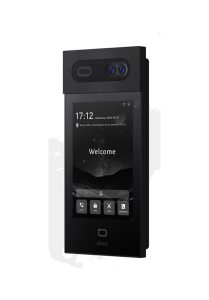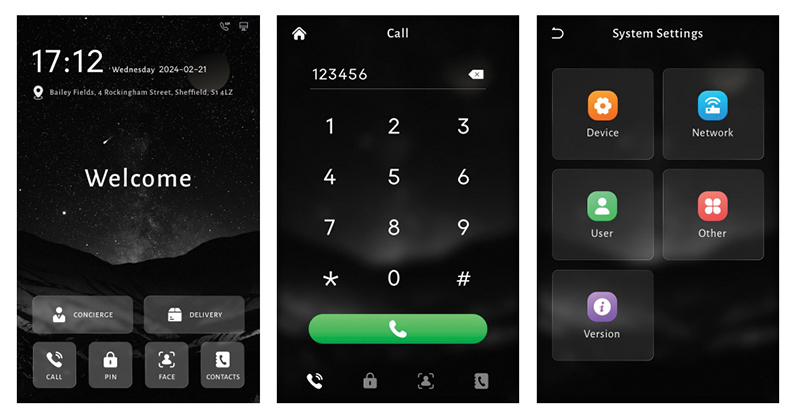 The Dnake S617 door station includes a portrait mode 8” capacitive touch screen for user input and display using the Android operating system. It uses a 2MP 120° wide angle lens camera with wide dynamic range capability and automatic lighting support. It is IP65 environmental and IK08 impact rated.
The Dnake S617 door station includes a portrait mode 8” capacitive touch screen for user input and display using the Android operating system. It uses a 2MP 120° wide angle lens camera with wide dynamic range capability and automatic lighting support. It is IP65 environmental and IK08 impact rated.
Access can be granted using Card, PIN code, Bluetooth, facial recognition technology or remote connection. Its user display screen resolution is 1280 x 800 pixels. Three output relays are available for door lock control.
The door station was supplied for review along with an H618 indoor monitor, a 10.1” touch-screen LCD that can support up to 16 IP cameras. This also has a 1280 x 800-pixel resolution with ethernet and Wi-Fi connectivity.
As a system these devices can be configured as a one-to-one standalone entry, or up to 9 door stations and in excess of 9000 indoor viewers can be combined for large or widely distributed installations. Up to 20,000 users, 20,000 faces, and 60,000 cards can be stored with 500 unlock logs being recorded.
Both devices support SIP 2.0 (Session Initiation Protocol) for VoIP communication.
Getting started
Both devices can be PoE or 12v DC supplied, with the door station requiring PoE+ 16W operating power (8W standby) and the indoor display 10W (3W standby). In use these gave actual PoE readings of up to 12W on loading, 8.5W on display and ~6.5W on standby; the indoor unit read ~9.9W on loading followed by approximately 4.5W in use and 1.8W on standby.
Dimensions of the flush mounted door station are 140 x 300 x 38mm and for the indoor viewer, 265 x 160 x 22 mm, although the rear mounted RJ45 connector must be taken into account.
At the rear of the door station are two twelve-way push-fit connectors either side of the RJ45 PoE network connector. The left-hand connector provides for 12v input, Ground, Weigand D0 and D1, then four inputs with associated ground connections. The right-hand connectors are for three relay outputs consisting of normally open and closed with associate commons and then an RS485 pair for serial communications.

With the relay connectors of the device being on the insecure side of the building, care must be taken if using the door station for perimeter door release. A rear-mounted tamper switch can be enabled to create an alarm if the unit is compromised.
Both devices had DHCP on by default so could be found on the target network and the door station connected to the indoor viewer, though these may have been pre-configured prior to the testing.
Time and date are likely to be configured for Beijing time (GMT +8) so must be set on both devices. NTP is on by default and this service can be changed to suit the installation.
Read the full review in the October 2024 edition of PSi magazine

